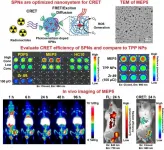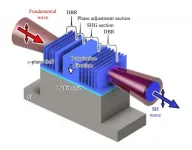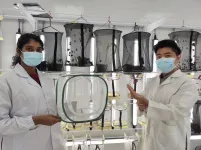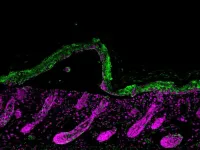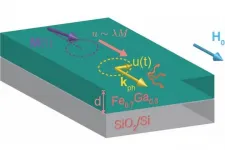(Press-News.org) Reston, VA (Embargoed until 12:30 p.m. EDT, Monday, June 14, 2021) - Researchers have successfully developed a novel cancer treatment approach that utilizes Cerenkov radiation energy to target and destroy cancer cells more effectively. The approach uses light from decaying radiopharmaceuticals, known as Cerenkov luminescence, as an energy source to activate semiconducting polymer nanoparticles that kill cancer cells. This research was presented at the Society of Nuclear Medicine and Molecular Imaging's 2021 Virtual Annual Meeting.
Over the past several decades, many studies have been conducted on photodynamic therapy, which uses an external light source to activate nanomaterials for cancer therapy. This therapy, however, is limited by the ability of external light to penetrate tissues. As Cerenkov luminescence is spontaneously produced from certain radiopharmaceuticals as they decay in the body, it has recently been proposed as an internal energy source for cancer therapy.
While Cerenkov luminescence is advantageous because it is a light source produced inside of the body, the light source is generally very weak. "The good news is that the light source can be amplified with semiconducting polymers, which greatly increases its potential to target and destroy cancer cells," said Zachary Rosenkrans, graduate research assistant at University of Wisconsin-Madison in Madison, Wisconsin. "In our study we aimed to determine how to best utilize radiopharmaceuticals and nanoparticles to create the ideal cancer theranostics nanosystem."
Researchers found that semiconducting polymer nanoparticles optimized with photosensitizers dramatically intensified Cerenkov luminescence to kill cancer cells. Positron emission tomography and optical imaging studies also clearly visualized tumor uptake of these optimized semiconducting polymer nanoparticles. This approach was found to have excellent potential as a cancer theranostics nanosystem without any tissue penetration limits.
"This work is an important step toward translating nanomaterials that are activated by light, using radiopharmaceuticals as an activation source. The basic concept, using semiconducting polymers to harness and amplify light produced from radiopharmaceuticals, is also very exciting and could have many interesting applications in the future," Rosenkrans noted.
Abstract 71. "Semiconducting polymers enhance Cerenkov radiation energy transfer for multimodal cancer theranostics," Zachary Rosenkrans, Dalong NI, Kaelyn Becker, Eduardo Aluicio-Sarduy, Jonathan Engle, and Weibo Cai, University of Wisconsin-Madison, Madison, Wisconsin.
INFORMATION:
All 2021 SNMMI Annual Meeting abstracts can be found online at https://jnm.snmjournals.org/content/62/supplement_1.
About the Society of Nuclear Medicine and Molecular Imaging
The Society of Nuclear Medicine and Molecular Imaging (SNMMI) is an international scientific and medical organization dedicated to advancing nuclear medicine and molecular imaging, vital elements of precision medicine that allow diagnosis and treatment to be tailored to individual patients in order to achieve the best possible outcomes.
SNMMI's members set the standard for molecular imaging and nuclear medicine practice by creating guidelines, sharing information through journals and meetings and leading advocacy on key issues that affect molecular imaging and therapy research and practice. For more information, visit http://www.snmmi.org.
Alzheimer's disease is the most common form of dementia and is characterized by neurodegeneration in regions of the brain involved in memory and learning. Amyloid beta and tau are two toxic proteins that build up in disease and cause eventual neuronal death, but little is known about how other cells in the brain react during disease progression.
A new study from the ASU-Banner Neurodegenerative Research Center (NDRC) and MIT/Koch Institute sheds new light on how disease processes manifest in patients with Alzheimer's disease.
Diego Mastroeni of the NDRC teamed up Forest White and Douglas Lauffenburger, colleagues in MIT's Department of Biological Engineering, to explore how protein ...
Osaka, Japan - Researchers from the Graduate School of Engineering and the Center for Quantum Information and Quantum Biology at Osaka University unveiled a new solid state second-harmonic generation (SHG) device that converts infrared radiation into blue light. This work may lead to a practical daily-use deep ultraviolet light source for sterilization and disinfection.
Recently, deep ultraviolet (DUV) light sources have been attracting much attention in sterilization and disinfection. In order to realize a bactericidal effect while ensuring user safety, a wavelength range of 220-230 nm is desirable. ...
Singapore, 14 June 2021 - Many butterfly species bear distinct circular markings known as eyespots on their wings, and the functions of these rings of contrasting colours vary. A long-standing theory is that they serve as anti-predator defences - small eyespots along the wing margin can protect butterflies by directing predators to attack less important parts of the body, such as the hindwings, enabling them to escape.
Most nymphalid family butterflies have half as many eyespots on their forewings compared to their hindwings. In particular, this has been observed in the bush brown butterfly Bicyclus anynana.
A recent research by biologists from the National University of Singapore (NUS) sought to understand the impact of uneven distribution of eyespots. ...
A team of scientists has shown that the healing of skin blisters is driven by hair follicle stem cells, which delay their own development in the process.
The healing process of the tissues in the human body is particularly well-studied in skin, especially as skin serves as a layer of protection from the environment. However, there remain some specific types of skin injuries where the healing process is not well understood.
A team of scientists from Japan and Italy, including Associate Professor Ken Natsuga from the Graduate School of Medicine at Hokkaido University, have used models of skin blisters to explore the effects of injury on developing skin tissue. Their discoveries ...
Nearly 12,000 people in Sweden received sickness benefit from the Swedish Social Insurance Agency for COVID-19 during the first wave of the pandemic. The median duration of sick leave in this group was 35 days, but for many it was considerably more long-drawn-out, according to a University of Gothenburg study.
A research group in rehabilitation medicine at the University of Gothenburg has studied sick-leave patterns. The study now presented in the scientific journal BMC Public Health.
The study included all recipients of sickness benefit from the Social Insurance Agency for COVID-19 diagnoses in Sweden during the first pandemic wave, from 1 March to 31 August 2020, and monitored them for 4 months from the start of ...
Artemisone is a promising substance in the fight against malaria. However, the active ingredient has yet to be used due its instability and because it is not easily absorbed by the body. A team from Martin Luther University Halle-Wittenberg (MLU) and the Hebrew University of Jerusalem has now pushed this a bit further. They have developed a very simple method for preparing the active ingredient that makes it easier to administer and store. The researchers report on their work in the scientific journal "Antimicrobial Agents and Chemotherapy".
Malaria is caused ...
High running capacity is associated with health and longevity. However, whether high genetic running capacity promotes more efficient metabolism with aging is not known. A new study conducted in collaboration between the universities of Shanghai Jiao Tong University (China) and Jyväskylä (Finland) investigated the effects of genetic running capacity and aging on tissue metabolism. The study reveals that adipose tissue may have a key role in healthy aging.
Running capacity, expressed as aerobic capacity, refers to an individual's capacity to utilize oxygen and is known to decrease with age, thereby affecting the whole body metabolism and health.
"We currently lack the information ...
A team of neuroscientists are calling for greater support of neuroscience research in Africa following a long-term analysis of research outputs in the continent.
The findings detail important information about funding and international collaboration comparing activity in the continent to the US, UK and areas of Europe. It's hoped that the study will provide useful data to help shape and grow science in Africa.
Africa has the world's largest human genetic diversity which carries important implications for understanding human diseases, including neurological disorders.
Co-lead ...
Hurricanes that make landfall typically decay but sometimes transition into extratropical cyclones and re-intensify, causing widespread damage to inland communities
The presence of a cold core is currently used to identify this transition, but a new study has now found that a cold core naturally forms in all landfalling hurricanes
The cold core was detected when scientists ran simulations of landfalling hurricanes that accounted for moisture stored within the cyclone
Over time, the scientists saw a cold core growing from the bottom of the hurricane, replacing the warm core
The research could help forecasters make more ...
A study led by University of Minnesota Twin Cities researchers uncovered a property of magnetic materials that will allow engineers to develop more efficient spintronic devices in the future. Spintronics focuses on using the magnetic "spin" property of electrons instead of their charge, which improves the speed and efficiency of devices used for computing and data storage.
The research is published in Physical Review B, a peer-reviewed scientific journal published by the American Physical Society.
One of the major roadblocks in developing better spintronic devices is an effect called "damping," in which the magnetic energy essentially leaks out of the materials, causing them to be less efficient. Traditionally, scientists ...
